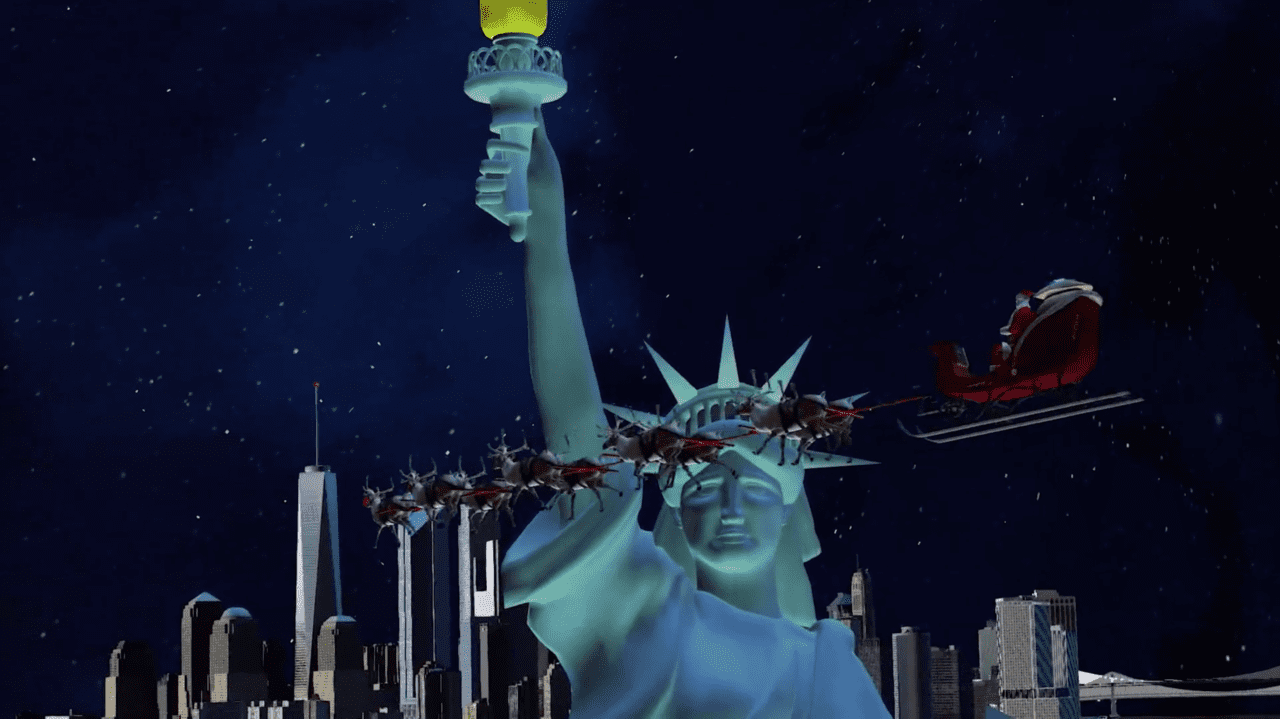
A 3D rendering of Santa flying past the Statue of Liberty in New York in AGI’s STK software. (AGI, AVI screenshot)
Tracking Santa’s route isn’t as simple as drawing a line that connects the cities of the world; His sleigh has a weight to it, it has a maximum climb rate, it has a bank angle for a given turn radius. It’s an actual object, an aircraft with attributes that have to obey the laws of physics.
That’s why the North American Aerospace Defense Command (NORAD) brings in Analytics Graphics, Inc. (AGI) to help with the daunting task of tracking St. Nick. AGI has been working with NORAD since 1990 and got involved with the agency’s Santa-tracking efforts in 1997, according to AGI CEO and co-founder Paul Graziani.
“It was just us and NORAD the first year,” Graziani said. “We stood the server up, just put it on our normal servers. I went into work and logged onto the site to check it out early on Christmas Eve, and I couldn’t get onto the site. Turns out, we were getting hammered from millions of people.”
The following year, AGI and NORAD brought in IBM, which was coming off hosting the Nagano Olympics website, to host the Santa Tracker.
Since then, more companies have gotten involved. There are games, movies, an app so you can keep up to date on the jingly one’s current whereabouts. AGI is responsible for the tracker itself, providing its software to build and render everything that makes that possible, as well as the hourly videos that capture Santa whisking through different cities around the world.
Outside of the Santa Tracker, AGI’s systems toolkit (STK) is used for a range of aerospace and maritime applications. On the front end, its modeling abilities are used in designing and planning. A soldier in the Marine Corps Combat Development Command used STK in conjunction with a script to simulate all the different scenarios for a mission and find out what UAS would best fit the requirements so he could submit a thorough proposal in one example Graziani gave.
STK also provides tracking. Operators use it to keep tabs on their assets, and users of those assets use it to help them act more efficiently — for example, aircraft carriers might need to know when they are going to exit the beam of one satellite and enter the beam of another for communications and navigation purposes.
More recently, STK is being used in unmanned traffic management, primarily through a subsidiary company called OneSky. OneSky uses AGI’s tools to help track drones in urban environments. As well as Google and Amazon, it is one of less than half-a-dozen companies working with the U.S. government on beyond visual line of sight drone tracking, according to Graziani.
“I do worry that the U.S.—we’re so heavily regulated that other nations, New Zealand, Singapore, a few other countries — China, obviously — they’re running, and they don’t have the regulatory hurdles that we have here,” Graziani said.
OneSky has also sold its solution to Singapore for use in package delivery.
If it sounds like STK can do a lot, it can. That’s really its strength, Graziani said.
“STK is very much like a spreadsheet,” he said. “You can do so much with it. You can do just about anything with the product.”
That ability to do anything is why, he said, almost every company with any ties to national security has a copy — Northrop Grumman, Lockheed Martin, Boeing, as well as all the federal agencies such as the CIA and branches of the service. It adds up to over 50,000 users.
“I like to say we’re an inch deep but a mile wide,” Graziani said.
That width expands to tracking Santa each year, an undertaking which starts a few months before the big day, when all the companies involved begin weekly calls to determine what new features will be implemented.
The STK software plans the route (in concert with Santa’s elves, AGI representatives point out). Once the sleigh vehicle is built and its performance is defined, an operator at AGI can put destinations into the aviator module, which then calculates the route to hit all the necessary locations at the required times. If a new city is going to be visited, 3D modeling is necessary to show Santa and the reindeer there, especially for any signature landmarks that are going to be depicted.
It takes a lot of work keeping up with Santa each year — Graziani said some people around the company would be mad if they found out how much — but he thinks helping to provide it for the 20 million-odd annual visitors is a valuable duty.
“It’s cool to get this kind of a face out to the world for NORAD,” Graziani said.